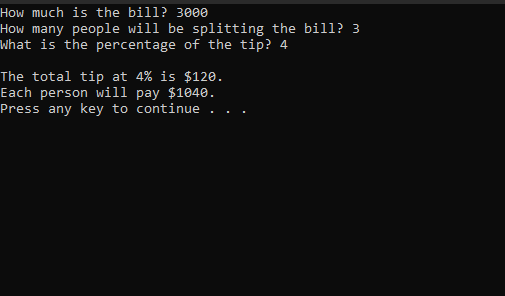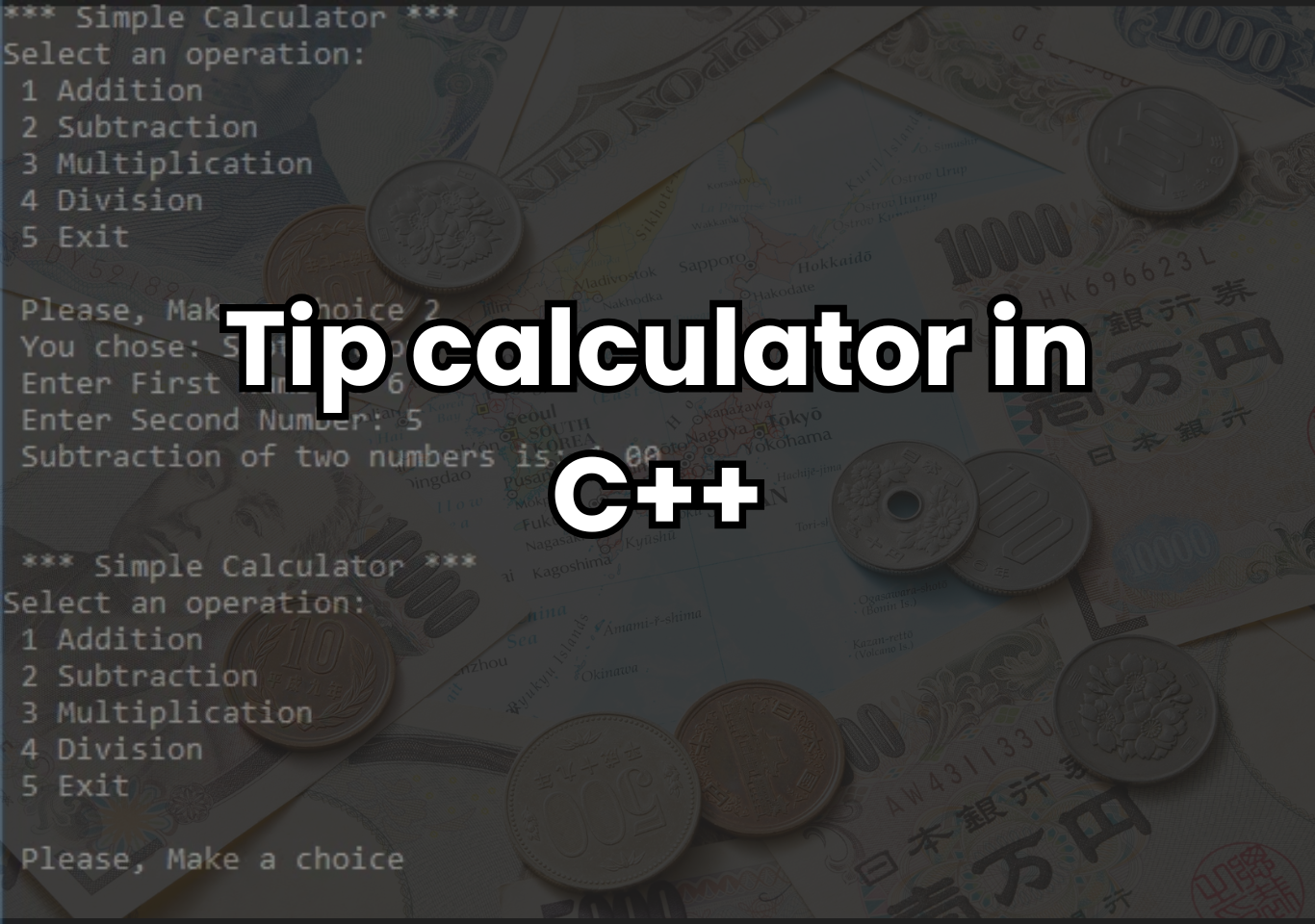Introduction
A tip calculator is a simple program designed to quickly determine how much additional money should be added to a bill, based on a chosen percentage. Tip calculator is a tip-based project built in c plus plus (C++).
In the world of restaurant bills, splitting checks and calculating money manually can be difficult and might lead to errors. A tip calculator automates that task, improving accuracy and user experience. While many examples of tip calculators exist in scripting languages or mobile apps, implementing one in C++ offers learning opportunities in type handling, user interface, modular design, and numerical accuracy. It helps users avoid manual math when paying at restaurants, cafes, or services where tipping is accepted. The calculator typically takes three inputs: the total bill amount, the tip percentage, and optionally the number of people sharing the bill. The program generates the outputs based on the user’s request.
In C++, building a tip calculator teaches beginners about variables, arithmetic operations, input/output handling, and precision formatting. It also emphasizes accuracy in floating-point calculations and proper rounding when dealing with currency values. A well-designed version can include features like customizable tip percentages, tax adjustment, and split billing. After the calculation is done, you will see the result of how much each person should pay. This code is easy to understand. You need to compile and execute the program to see how the program works. It has a command-line interface and is very easy to use and implement.

Why Build a Tip Calculator in C++
- Practical Use Case: Demonstrates how software simplifies real-life tasks with an everyday solution.
- Teaches Core Concepts: Covers variables, user input/output, arithmetic operators, and type conversion.
- Precision Handling: Provides fine control over number formatting and rounding for accurate currency calculations.
- Error Management: Allows input validation and exception handling to make the program robust.
- Scalability: Can be adapted for applications, GUIs, or embedded systems.
Step-by-step flow
Even without using code, it’s important to understand the logical flow. The tip calculator project operates through a clear input, process, and output cycle.
- Input Stage – The user enters the bill amount, tip percentage, and number of people sharing the bill.
- Processing Stage – The program calculates the tip. Then it adds the tip to the original bill to get the total.
- Splitting Stage – If multiple people share the bill, the total is divided equally among them.
- Output Stage – The program displays the tip, total bill, and per-person share, formatted to two decimal places.
Key concepts in the tip calculator
Variables and Data Types
The program uses a floating-point variable to store decimal values like the bill amount and the tip percentage. Using double is preferred for accuracy in financial computations.
Arithmetic Operations
Multiplication, division, and addition form the mathematical core. These are handled using basic operators (+ × ÷ – ), reinforcing the foundational understanding of arithmetic logic in C++.
Input and Output Handling
User interaction happens through input/output streams. Knowing how data flows between the user and the program is vital.
Data Validation
Good programs never trust raw input. A tip calculator must ensure that the entered values are positive and meaningful.
Rounding and Formatting
Displaying two decimal places improves readability and maintains financial precision. Understanding rounding helps prevent floating-point inaccuracies.
Modularity
Each part of the logic (input, calculation, output) can be broken into separate functions. Modularity ensures easier testing and debugging.
Benefits of Building a Tip Calculator
- Enhances logic building
- Improves numeric accuracy
- Builds debugging habits
- Teaches user experience design
- Foundation for real projects
Common Mistakes by Beginners
When beginners attempt this project, they often make predictable mistakes, such as:
- Using float instead of double leads to rounding errors.
- Ignoring invalid inputs leads to the results in crashes.
- Not handling division by 0 when the number of people is set to zero.
- Formatting inconsistencies show too many or too few decimals.
- Hardcoding tip percentage instead of allowing custom input.
- Overflow for extremely large bill or tip percentages.
- Poor user prompts or error messages confuse the user.
- No modular separation leads to monolithic, messy code.
After finishing the project, make sure that the project provides a good user experience.
User Interaction Flow
Here is a conceptual flow:
- Print a welcome or header: “Tip Calculator (C++)”
- Prompt: “Enter bill amount: ”
- Read input, validate. If invalid, show error and re-prompt.
- Prompt: “Enter tip percentage (e.g. 15 for 15%): ”
- Read and validate.
- Prompt: “Enter number of people (default 1): ”
- Read and validate.
- Compute tip, total, per-person share.
- Display results:
- Tip amount: $0.00
- Total including tip: $0.00
- Each person pays: $0.00 (if >1 person)
- Ask: “Do you want to compute another?” loop until exit.
How to use this tip calc project?
- Download the project and extract the source code.
- Open DevC++ or any other.
- Open the project folder in the editor.
- Compile and Execute.
- Enjoy and share.
Click the button below to download the complete source code for this Tip Calculator in C++ project and explore how each function works in real time. Get hands-on experience, test the logic yourself, and see how simple concepts turn into a fully functional program.



certainly like your website but you need to take a look at the spelling on quite a few of your posts Many of them are rife with spelling problems and I find it very troublesome to inform the reality nevertheless I will definitely come back again
Just wish to say your article is as surprising The clearness in your post is just cool and i could assume youre an expert on this subject Fine with your permission allow me to grab your RSS feed to keep updated with forthcoming post Thanks a million and please keep up the enjoyable work
Your blog is a beacon of light in the often murky waters of online content. Your thoughtful analysis and insightful commentary never fail to leave a lasting impression. Keep up the amazing work!
Your blog is a breath of fresh air in the crowded online space. I appreciate the unique perspective you bring to every topic you cover. Keep up the fantastic work!